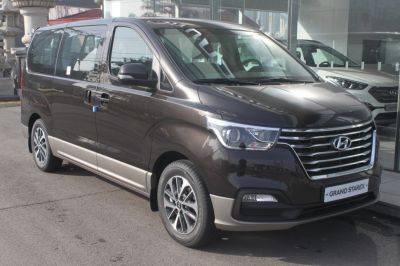 2008 Hyundai H-1 II Cargo Dimensions, Size & Specs
2008 Hyundai H-1 II Cargo Dimensions, Size & Specs
Measurements of the 2008 Hyundai H-1 II Cargo, engineered for optimal performance and comfort
| Dimensions | |
|---|---|
| Length: | 5150 mm202.8 in16.9 ft |
| Width: | 1920 mm75.6 in6.3 ft |
| Height: | 1925 mm75.8 in6.3 ft |
| Trunk Capacity (Max): | 3440-5190 liter121.5-183.3 cu ft |
| Weight Specifications | |
| Curb Weight: | 1974-2089 kg4352-4605 lbs |
| Maximal permitted Weight: | 3160-3230 kg6967-7121 lbs |
| Roof Load: | 80 kg176 lbs |
| Tire Specifications | |
| Rims Size: | 16-inch rims:
|
| Tire Size: |
|
The Hyundai H-1 II Cargo generation, produced between 2008 and 2015, is a versatile minivan designed primarily for cargo and commercial use, offering a practical balance of size, weight, and capacity. Measuring 5150 mm (202.8 inches) in length, 1920 mm (75.6 inches) in width, and 1925 mm (75.8 inches) in height, the H-1 II Cargo provides ample interior space while maintaining manageable external dimensions for urban and highway driving.
With a curb weight ranging from approximately 1974 to 2089 kg (4353 to 4605 lbs) and a maximum gross weight between 3160 and 3230 kg (6968 to 7119 lbs), this minivan supports various load demands without sacrificing performance. The significant cargo space is one of its standout features, offering a rear luggage capacity between 3440 and 5190 liters (121.5 to 183.3 cubic feet) when the rear seats are folded down, ideal for transporting bulky items.
The roof load capacity is rated at 80 kg (176 lbs), adding flexibility for additional storage or equipment. This vehicle rides on 6.5 J x 16 inch rims equipped with 215/70 R16 tires, balancing ground clearance and stability. The Hyundai H-1 II Cargo is well-suited for businesses requiring a reliable and spacious minivan capable of handling diverse cargo requirements while ensuring comfort and safety.
Discover the standout features that make the 2008 Hyundai H-1 II Cargo a leader in its class
Have a question? Please check our knowledgebase first.
The Hyundai H-1 II Cargo generation, produced from 2008 to 2015, has an overall length of 5150 mm (202.8 inches), a width of 1920 mm (75.6 inches), and a height of 1925 mm (75.8 inches). These dimensions place it firmly in the minivan/light commercial vehicle category. The size allows for a spacious cargo area and good maneuverability considering its vehicle class, making it suitable for commercial and logistics purposes.
The curb weight of the Hyundai H-1 II Cargo ranges from 1974 kg to 2089 kg (4353 to 4605 lbs), depending on the variant and equipment level. The maximum permissible weight (gross vehicle weight rating) is between 3160 kg and 3230 kg (6968 to 7120 lbs). This means the van is designed to carry a substantial payload, making it ideal for cargo transport and commercial use.
The Hyundai H-1 II Cargo offers exceptional luggage capacity, ranging from 3440 liters up to 5190 liters (121.5 to 183.3 cubic feet) when the rear seats are folded or removed. This very large cargo volume makes it an excellent choice for businesses requiring significant load space, such as transport, delivery, or mobile service operations.
The standard tires for the Hyundai H-1 II Cargo are sized 215/70 R16, mounted on 16-inch rims with a specification of 6.5 J x 16. These specifications are typical for vehicles in this class, offering a balance between load capability, ride comfort, and durability.
The roof load capacity of the Hyundai H-1 II Cargo is rated at 80 kg (176 lbs). This means when carrying items on the roof rack or roof bars, the total weight should not exceed this limit to ensure vehicle safety and stability. It is suitable for light roof racks, luggage boxes, or equipment but not for heavy cargo.
The Hyundai H-1 II Cargo’s height of 1925 mm (about 6 feet 4 inches) and width of 1920 mm (around 6 feet 4 inches) mean it can be a tight fit for many standard residential garages, which usually have door heights ranging between 2.1 to 2.4 meters and widths around 2.4 to 2.7 meters. While the height should generally clear typical garage doors, the width requires careful consideration to maneuver in and out, especially in garages with narrow entrances or limited room on sides.
Compared to the earlier generation of the Hyundai H-1, the H-1 II Cargo introduced in 2008 features refined exterior styling but maintains very similar overall dimensions. While some minor dimensional adjustments may have been made for modernization and meeting regulatory requirements, the length of approximately 5150 mm, width around 1920 mm, and height about 1925 mm remain consistent. Improvements focused more on interior configuration, engine options, and overall utility rather than dramatic changes in size.
The Hyundai H-1 II Cargo competes with mid-size commercial vans such as the Ford Transit, Volkswagen Transporter, and Mercedes-Benz Vito. It is slightly longer than many conventional mid-size vans, with its 5150 mm (202.8 inches) length offering more cargo volume. Its luggage capacity of up to 5190 liters (183.3 cubic feet) with seats folded is on the higher end for the segment. While some competitors may offer different configurations and payload capacities, the H-1 II Cargo’s combination of size, load volume, and roof load balance make it a versatile and competitive option for commercial users.
The Hyundai H-1 II Cargo excels in its large cargo capacity, solid build quality, and competitive dimensions that maximize interior space without making the vehicle cumbersome to drive in urban environments. It offers robust payload abilities with its maximum weight up to 3230 kg (7120 lbs) and efficient use of interior space with flexible seating configurations to increase cargo volume. Additionally, it supports relatively modest roof load capacities suitable for extra cargo or equipment. Its durability and moderate size provide an ideal balance for freight, delivery, and shuttle applications.
The Hyundai H-1 II Cargo is primarily designed with commercial use in mind, especially cargo transport and shuttle services. Its large dimensions, high payload, and configurable interior make it efficient for business purposes. While it can be adapted for personal or family use, especially in variant trim levels with passenger seating, its size and commercial design focus might be excessive for typical personal transportation needs. Potential owners should weigh their cargo and passenger needs carefully before choosing this model for personal use.
Discover similar sized cars.

| Production: | 2023-present |
|---|---|
| Model Year: | 2024 |
| Length: | 5125 mm201.8 in |
| Width: | 1890 mm74.4 in |
| Height: | 1930-1955 mm76.0-77.0 in |

| Production: | 2018-present |
|---|---|
| Model Year: | 2018 |
| Length: | 5150 mm202.8 in |
| Width: | 1920 mm75.6 in |
| Height: | 1935 mm76.2 in |

| Production: | 2018-present |
|---|---|
| Model Year: | 2018 |
| Length: | 5150 mm202.8 in |
| Width: | 1920 mm75.6 in |
| Height: | 1925 mm75.8 in |

| Production: | 2018-present |
|---|---|
| Model Year: | 2018 |
| Length: | 5169 mm203.5 in |
| Width: | 1920 mm75.6 in |
| Height: | 1925 mm75.8 in |

| Production: | 2015-2018 |
|---|---|
| Model Year: | 2015 |
| Length: | 5150 mm202.8 in |
| Width: | 1920 mm75.6 in |
| Height: | 1935 mm76.2 in |

| Production: | 2015-2018 |
|---|---|
| Model Year: | 2015 |
| Length: | 5150 mm202.8 in |
| Width: | 1920 mm75.6 in |
| Height: | 1925 mm75.8 in |

| Production: | 2008-2015 |
|---|---|
| Model Year: | 2008 |
| Length: | 5150 mm202.8 in |
| Width: | 1920 mm75.6 in |
| Height: | 1925 mm75.8 in |
